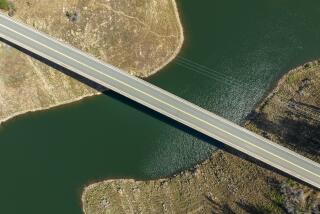Editorial: All that rain and snow! How can California still be in drought?

- Share via
After more than two months of atmospheric rivers and bomb cyclones, amid a supersized Sierra snowcap, and with more precipitation forecast for the rest of the month, isn’t California’s drought over?
The U.S. Drought Monitor reports that yes, 17% of California is now out of drought. Most of the rest of the state is quite wet as well, although it remains in some level of “drought” as the term is defined by the Drought Monitor.
Only 17%? How is that possible? We’ve had more rain and snow than in the entire winter of 2019, when the state was last declared drought free.
The cognitive dissonance is the result of the word “drought,” which scientists use to describe a set of measurable conditions in the soil, the atmosphere, plant life, rivers and reservoirs. For most of us, though, drought ends when it rains.
Even as California gets yet another atmospheric river blast and snowpack nears twice the average for this date, we’re still in grave danger of running out of water.
Consider the Great Plains during the 1930s. Now, that was a drought everyone could understand. When the rain stopped in 1930, the soil dried up and blew away. Destitute farmers moved from Oklahoma and adjacent states to the San Joaquin Valley. In 1939, it finally rained again. The drought was broken, the soil recovered, the corn and wheat grew, the U.S. became the breadbasket of the world, and everything was back to normal.
Unfortunately, much of that narrative is myth, and in any case irrelevant to the terrain and hydrology of California in an era of heat waves, longer summers and urban living.
Drought was never the right word to apply to this state’s dry streaks. Californians need a term that describes not just how much water is coming in, but how much we use every day and how much we save for later. We need a word or phrase that suggests how long we can stand in the shower, whether farmers can keep growing pistachios and if the forests and cities will once again burn when summer comes.
Instead of drought, we should talk about going into water debt, and refer to wet periods as winning the water lottery.
If ‘drought’ means a period of dry years followed by a return to the norm, California is not in drought. The current climate is the norm.
And isn’t a wet winter like this one a lot like winning the lottery? Most jackpot winners expect their lifestyles to change forever. But then they pay off their debts and the taxes on their winnings, and indulge in a few extravagances. Next thing they know, they’re right back where they started — except now with a taste for luxuries they can no longer afford. So they keep spending themselves further into debt.
California has developed a taste for almond groves and lawns that need water in amounts we’ll never have, even after a wet winter lottery. This year’s rain and snow help pay down a bit of our water debt by refilling once-empty reservoirs in Northern and Central California. But it did not change conditions at Lakes Mead and Powell on the Colorado River, which supplies much of Southern California’s water. Since 2000, when those reservoirs were last at capacity, we’ve been drawing them down to almost nothing. They were filled by an earlier jackpot that paid out during the 20th century, which was — the geological records tells us — an abnormally wet period.
We also continue to overdraw from some of our biggest water bank accounts, the aquifers under the San Joaquin Valley. To recharge those, we’d need to invest much more land and money into restoring floodplains to allow winter stormwater to settle and percolate into the soil over time, as it did until the early 20th century at formerly sprawling but now-vanished Tulare Lake and Buena Vista Lake. Meanwhile, even some empty aquifers are disappearing, as dried-out subterranean layers compact and lose their ability to hold moisture. It’s as if we won the lottery, gave up our job, blew through our winnings, spent all our savings and then burned down the bank.
This is not a uniquely California story. At the end of the Dust Bowl drought, the rains returned, but farmers wanted more and began pumping from the Ogallala Aquifer, a Great-Lake-sized underground water source created over thousands of years. As in the San Joaquin Valley, over-pumping is depleting Great Plains groundwater at a shocking rate, and without better stewardship it could all be gone by the end of this century.
We don’t tend to call that kind of depletion a drought. But the U.S. is building up a national water debt that can never be managed the way we handle our more traditional debt. We can always print more money, but we can’t print more water. We have to do a better job of managing what we’ve got.
More to Read
A cure for the common opinion
Get thought-provoking perspectives with our weekly newsletter.
You may occasionally receive promotional content from the Los Angeles Times.










